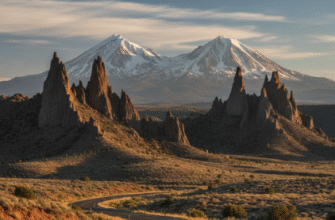The trees don’t care that you drove eight hours to see them.
I used to think ancient meant hidden—tucked away in some misty forest where sunlight filters through moss and everything feels like a secret. Then I drove California State Route 168 east out of Big Pine, climbed 23 miles of switchbacks into the White Mountains, and found the oldest living things on Earth standing in what looks like a parking lot for the apocalypse. Bristlecone pines, gnarled and stripped bare by wind, clinging to dolomite slopes at 10,000 feet where almost nothing else survives. Some of these trees were already a thousand years old when the pyramids went up. The oldest confirmed specimen—they won’t tell you exactly which one, to protect it—has been alive for over 4,800 years, give or take a few decades depending on which dendrochronologist you ask. Here’s the thing: they thrive *because* conditions are terrible. Poor soil, brutal winds, short growing seasons. It forces them to grow slowly, densely, which makes their wood nearly rot-proof. A dead bristlecone can stand for another thousand years, polished silver by sand and time.
The Ancient Bristlecone Scenic Byway isn’t actually a byway in the federal designation sense, which confused me at first. It’s more like a really good dirt road with a name. Route 168 takes you to the Schulman Grove visitor center, where the pavement ends and the interpretive trails begin. Two main loops: the Methuselah Trail (4.5 miles) and the Discovery Trail (one mile, easier). Both are self-guided, and honestly the signage feels a little spare—like they assume you’ll figure out why a tree that looks dead is actually just conserving resources in its one living strip of bark.
What Happens to Your Body When You Hike at Elevation Without Thinking About It First
Altitude hits different when you’re not expecting it. I’ve seen people—myself included, the first time—step out of the car at Schulman Grove, feel fine, then twenty minutes into the Methuselah Trail start wondering why their lungs forgot how to work. At 10,000 feet there’s roughly 30% less oxygen than at sea level, and your body notices even if your brain doesn’t. Headaches, nausea, that weird lightheaded feeling where you can’t tell if you’re tired or dying. The Park Service recommends acclimating, drinking water, going slow. Most people don’t. They drive up in one shot, walk too fast because the trail looks easy, then spend the next hour sitting on a rock recalibrating their expectations. Wait—maybe that’s just me. Anyway, the point is: these trees have adapted to low oxygen, freezing nights, and wind that would strip paint off a car. You, probably, have not.
The road continues past Schulman Grove another 12 miles to the Patriarch Grove, which sits even higher at 11,000 feet. This section is usually open July through October, depending on snow. The Patriarch Tree itself has the largest trunk circumference of any bristlecone—36 feet around, stubby and multi-stemmed like something out of a Tim Burton sketch. Fewer people make it up here, which means you might actually get silence, the kind that feels physical in thin air.
Why the White Mountains Look Like Mars But Aren’t Completely Lifeless Even Though They Definitely Seem That Way
Dolomite is a weird rock. It’s pale, crumbly, alkaline—most plants hate it. The White Mountains are named for the stone, not snow, though there’s plenty of that too depending on season. What grows here has to be a specialist: bristlecones, some limber pines at lower elevations, scattered sagebrush, a few hardy wildflowers in July. The landscape has this stripped-down, elemental quality, like someone deleted all the unnecessary details. I guess it makes sense that NASA has used the area for Mars analog research—the soil chemistry and sparse vegetation apparently resemble what rovers find in certain Martian basins, or at least that’s what I read somewhere, though I couldn’t tell you which mission.
The byway is typically accessible from late May through October. Winter closes everything above Big Pine. No services once you leave town—no gas, no water, no cell signal. The visitor center at Schulman Grove has restrooms and a small bookstore, but it’s only staffed seasonally. Entrance is $6 per person or free with an Inyo National Forest pass. If you’re planning to camp, there are a few sites at Grandview Campground (8,600 feet), first-come first-served, no water. I’ve stayed there once. It was August and still dropped below freezing at night, which I definately wasn’t prepared for.
The Trees Don’t Perform and That’s the Whole Point I Think
There’s no climax moment on the Methuselah Trail. You walk, you see trees, some are alive, some look like driftwood sculptures, none of them are labeled “THIS IS THE OLD ONE.” You’re surrounded by millennia and you just have to sit with that, without confirmation, without a photo op that proves you saw the right thing. Turns out the bristlecones don’t twist into those iconic tortured shapes to be beautiful—they do it to survive. Wind shear, ice damage, lightning strikes. A tree might lose 90% of its bark and keep going on one narrow cambium strip, routing water and nutrients up through a single channel for another five hundred years. It’s the botanical equivalent of spite. I used to think ancient trees would feel sacred, maybe a little magical. These just feel stubborn. Exhausted. Still here.









